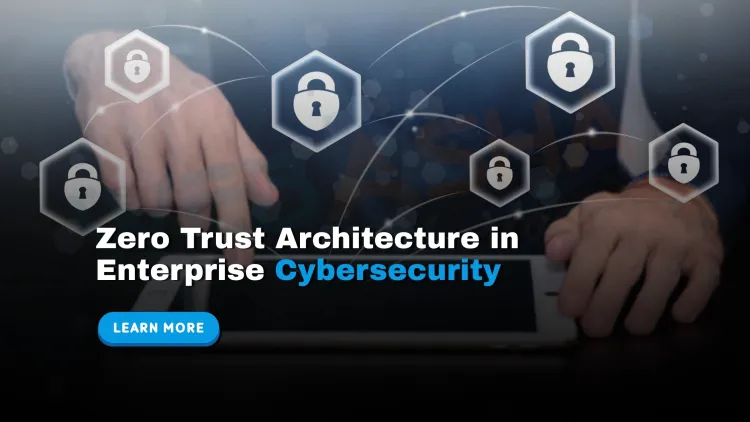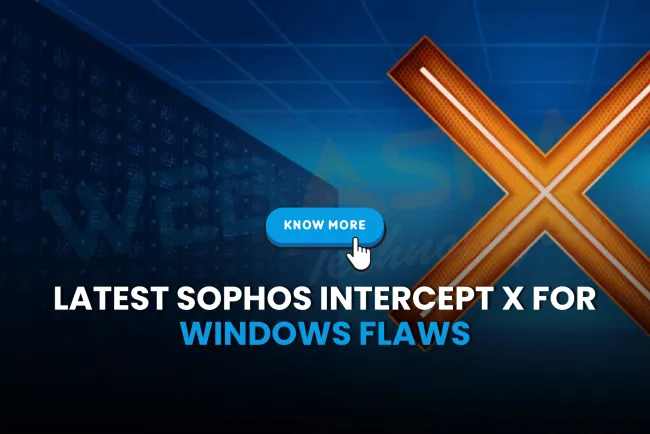What is Zero Trust Architecture and why is it important for modern enterprise cybersecurity?
Zero Trust Architecture (ZTA) is a security model that eliminates the concept of a trusted network perimeter. Instead of automatically trusting devices inside the network, ZTA enforces continuous verification of identity, access, and behavior—making it ideal for modern cloud environments, remote workforces, and evolving threat landscapes. It helps prevent data breaches, lateral movement of attackers, and unauthorized access. Modern companies like Google (BeyondCorp) and Microsoft have adopted Zero Trust to secure their systems, making it a key pillar for future enterprise security.

Table of Contents
- What is Zero Trust Architecture?
- Why Was Zero Trust Introduced?
- How Does Zero Trust Work?
- Components of a Zero Trust Architecture
- Real-World Use Cases of Zero Trust
- Benefits of Zero Trust for Enterprises
- Common Mistakes to Avoid When Implementing Zero Trust
- Steps to Implement Zero Trust in Your Organization
- Tools That Help You Build a Zero Trust Environment
- Future of Zero Trust
- Conclusion
- Frequently Asked Questions (FAQs)
In today’s complex digital world, traditional perimeter-based security is no longer enough. As more organizations move to the cloud and remote work becomes the norm, threats are now coming from both outside and inside the network. That’s where Zero Trust Architecture (ZTA) comes in — a modern security model that trusts nothing and verifies everything. This blog will explain Zero Trust in simple terms, how it works, and why it's the future of enterprise security.
What is Zero Trust Architecture?
Zero Trust Architecture is a security framework that assumes no user or device is trustworthy by default, even if they are inside the network perimeter. It enforces strict identity verification and access controls before allowing access to any resources.
Instead of the old model — "trust, but verify" — Zero Trust adopts a more realistic stance: "never trust, always verify."
Why Was Zero Trust Introduced?
Traditional network security trusted users and devices once they were inside the corporate firewall. However, this model failed in the face of:
-
Cloud adoption
-
Bring Your Own Device (BYOD) culture
-
Remote work
-
Insider threats
-
Sophisticated cyberattacks
High-profile breaches like SolarWinds and Colonial Pipeline showed that attackers could exploit trusted internal access. Zero Trust was designed to stop such lateral movement inside networks.
How Does Zero Trust Work?
Zero Trust relies on seven key principles:
-
Continuous Verification: Every user and device is authenticated and authorized for every access attempt.
-
Least Privilege Access: Users get only the access they need to perform their role.
-
Microsegmentation: The network is divided into small zones to limit movement.
-
Assume Breach: Operate as if attackers are already inside the network.
-
Contextual Access: Access is based on device health, location, time, and behavior.
-
Encryption Everywhere: All data, at rest or in transit, is encrypted.
-
Real-Time Monitoring: Constant activity monitoring using analytics and AI.
Components of a Zero Trust Architecture
| Component | Function |
|---|---|
| Identity Provider | Verifies user identity through MFA, biometrics, etc. |
| Device Trust Engine | Assesses device health, patch status, location, etc. |
| Policy Engine | Determines who can access what, when, and from where |
| Microsegmentation Tools | Divides network into secure segments |
| SIEM & XDR Integration | Provides security analytics and real-time alerts |
| VPN Replacement (ZTNA) | Allows secure access without full network exposure |
Real-World Use Cases of Zero Trust
1. Google’s BeyondCorp
Google was one of the first to implement Zero Trust with its BeyondCorp model. Employees access internal tools securely from any device and location without a VPN.
2. Microsoft’s Zero Trust Journey
Microsoft integrated Zero Trust across Azure AD, Defender, and Intune to protect hybrid and remote workforces. Their telemetry data helps detect and block threats in real-time.
3. Healthcare Sector
Hospitals use Zero Trust to protect sensitive patient data across IoT devices, mobile apps, and cloud environments, especially during telehealth sessions.
4. Financial Services
Banks implement Zero Trust to prevent fraud, protect customer data, and comply with regulations like GDPR and PCI-DSS.
Benefits of Zero Trust for Enterprises
-
Reduces risk of insider threats
-
Prevents lateral movement of attackers
-
Improves visibility and control
-
Supports cloud-first and remote-first strategies
-
Enhances regulatory compliance
Common Mistakes to Avoid When Implementing Zero Trust
-
Thinking it’s a one-time project: It’s a journey, not a quick fix.
-
Overlooking user experience: Too many verifications can frustrate users.
-
Ignoring legacy systems: These often become entry points for attackers.
-
Lack of executive buy-in: Without leadership support, policies may not be enforced.
Steps to Implement Zero Trust in Your Organization
-
Assess Current Security Posture
-
Identify Critical Assets and Data Flows
-
Apply MFA and Strong Identity Controls
-
Segment the Network (Microsegmentation)
-
Implement Context-Based Access Policies
-
Use Continuous Monitoring and Threat Detection
-
Train Staff and Align with Compliance Needs
Tools That Help You Build a Zero Trust Environment
| Tool/Platform | Function |
|---|---|
| Microsoft Azure AD | Identity and access management |
| Okta | SSO and identity verification |
| Zscaler Private Access | Zero Trust network access (ZTNA) |
| Palo Alto Prisma Access | Secure access and monitoring |
| CrowdStrike Falcon | Endpoint protection and threat intel |
| Illumio | Microsegmentation and traffic control |
Future of Zero Trust
As AI-driven attacks, IoT expansion, and hybrid work continue, Zero Trust will be essential for cyber resilience. Even governments (like the U.S. Federal Zero Trust Strategy) are mandating it.
AI will further enhance Zero Trust by enabling:
-
Predictive access policies
-
Real-time behavior-based decisions
-
Automated incident response
Conclusion
Zero Trust Architecture is not just a buzzword; it’s a strategic shift in how organizations secure their data, people, and assets. By eliminating implicit trust and applying granular policies based on identity, context, and behavior, Zero Trust ensures robust protection in an unpredictable threat landscape.
Whether you're a startup or an enterprise, embracing Zero Trust is critical for securing your future.
Frequently Asked Questions (FAQs)
What is Zero Trust Architecture in cybersecurity?
Zero Trust Architecture is a security approach where no user or system is automatically trusted, even if they are inside the network. Every access request is verified before it’s granted.
Why is Zero Trust better than traditional perimeter security?
Traditional models trust anything inside the network perimeter, while Zero Trust verifies each request individually, reducing the risk of internal threats and lateral movement by attackers.
How does Zero Trust work in remote and hybrid work environments?
It ensures that users and devices are continuously verified, regardless of location, making it ideal for remote and hybrid setups with cloud access.
Which companies use Zero Trust Architecture?
Companies like Google (with BeyondCorp), Microsoft, and Cisco have implemented Zero Trust principles to enhance their enterprise security posture.
What are the core principles of Zero Trust?
Verify explicitly, use least-privilege access, and assume breach. These guide the implementation of access controls and monitoring.
What technologies are used in Zero Trust?
Key technologies include identity and access management (IAM), multi-factor authentication (MFA), endpoint detection and response (EDR), microsegmentation, and secure access service edge (SASE).
Is Zero Trust only for large enterprises?
No, businesses of all sizes can benefit from Zero Trust, especially those relying on cloud platforms or with a distributed workforce.
How do I start implementing Zero Trust in my company?
Begin with defining your protect surface, mapping transaction flows, enforcing least privilege access, and deploying authentication and monitoring tools.
Can Zero Trust prevent ransomware attacks?
Yes, by verifying user behavior and restricting lateral movement, Zero Trust can help detect and stop ransomware spread within a network.
What is the role of identity verification in Zero Trust?
Identity verification ensures that users and devices are authenticated continuously before granting any level of access.
How does microsegmentation support Zero Trust?
Microsegmentation isolates workloads and limits network access, minimizing the attack surface and containing breaches.
What is the difference between Zero Trust and VPN?
VPN gives network access based on location, while Zero Trust verifies access based on identity and behavior, offering stronger security.
Is Zero Trust Architecture compliant with regulations like GDPR?
Yes, Zero Trust improves data protection and can help organizations meet compliance requirements like GDPR, HIPAA, and NIST.
How does ZTA affect user experience?
Although it adds more authentication steps, modern Zero Trust solutions are designed to be seamless and non-intrusive for verified users.
What is a real-world example of Zero Trust in action?
Google’s BeyondCorp is a practical example where employees securely access resources without VPN, using device security posture and identity checks.
Can Zero Trust be used with legacy systems?
Yes, though more challenging, Zero Trust principles can be adapted using network segmentation and proxy-based access control for legacy infrastructure.
What challenges are faced during Zero Trust implementation?
Challenges include legacy system compatibility, organizational change management, and integrating disparate tools.
How long does it take to implement Zero Trust?
Depending on the size and complexity of an organization, it may take several months to a year for full implementation.
What is least privilege access?
It means users only get the access necessary to perform their job, reducing the risk of accidental or malicious misuse.
Is Zero Trust the same as SASE?
No, SASE is a cloud-based architecture combining networking and security. Zero Trust is a philosophy that SASE can help implement.
Can AI be used in Zero Trust?
Yes, AI is used for behavioral analytics and anomaly detection to continuously validate users and devices.
What is the cost of Zero Trust implementation?
Costs vary depending on existing infrastructure, number of users, and required tools, but long-term ROI includes reduced breach risk.
How is Zero Trust different from traditional access control?
Traditional access often depends on network location, while Zero Trust enforces identity and context-aware access at all times.
Does Zero Trust stop insider threats?
It greatly reduces them by continuously monitoring user behavior and restricting unnecessary access.
Is Zero Trust suitable for cloud-native applications?
Absolutely, it is designed to protect dynamic cloud environments where traditional perimeters no longer apply.
How does Zero Trust protect APIs?
It ensures APIs are accessed securely with authentication, authorization, and behavioral monitoring to prevent abuse.
Can Zero Trust be automated?
Yes, automation through AI and machine learning enables real-time response, adaptive access, and streamlined policy enforcement.
How often should Zero Trust policies be reviewed?
Regularly—at least quarterly—to reflect changes in user roles, network architecture, and threat landscapes.
What certifications cover Zero Trust training?
Certifications like CISA, CISSP, and vendor-specific courses (e.g., Microsoft or Palo Alto Networks) offer ZTA-related training.
Will Zero Trust replace all security models?
Not entirely—it complements and enhances existing models, offering a more proactive and resilient defense mechanism.
Is Zero Trust future-proof?
While no model is fully future-proof, Zero Trust’s adaptable and evolving nature makes it highly effective against emerging threats.














![Top 10 Ethical Hackers in the World [2025]](https://www.webasha.com/blog/uploads/images/202408/image_100x75_66c2f983c207b.webp)








